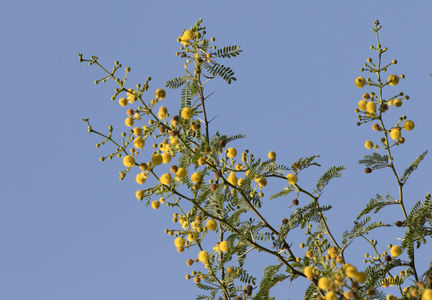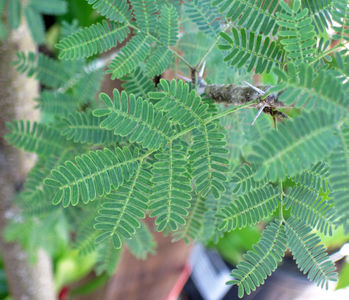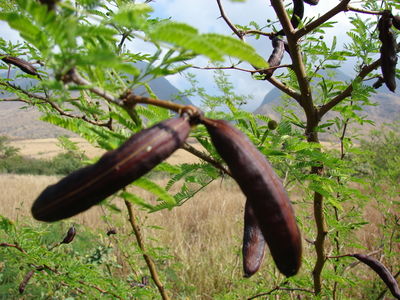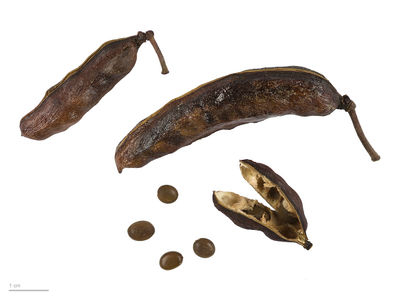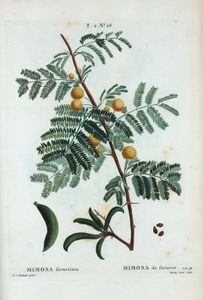Vachellia farnesiana : Différence entre versions
| (10 révisions intermédiaires par le même utilisateur non affichées) | |||
| Ligne 15 : | Ligne 15 : | ||
|titre=Résumé des usages | |titre=Résumé des usages | ||
|texte=*ornemental | |texte=*ornemental | ||
| − | *parfum : cassie | + | *parfum des fleurs : cassie |
*planté en haie et contre l'érosion | *planté en haie et contre l'érosion | ||
*écorce et gousses : tanin et colorant | *écorce et gousses : tanin et colorant | ||
| − | *bois d'œuvre | + | *bois d'œuvre dur, lourd |
| − | *gomme exsudée | + | *bois de feu |
| + | *gomme exsudée, ressemble à la gomme arabique | ||
| + | *médicinal : fleurs, graines, écorce, racine | ||
}} | }} | ||
== Description == | == Description == | ||
<gallery mode="packed"> | <gallery mode="packed"> | ||
| + | File:Acacia farnesiana PROSEA linedrawing.tif|1, rameau en fleur ; 2, glande du pétiole ; 3, apex mucroné du rachis d'une feuille ; 4, inflorescences ; 5, fruits mûrs (PROSEA). | ||
File:Acacia farnesiana, Adana 2017-07-12 01-1.jpg|rameaux en fleurs | File:Acacia farnesiana, Adana 2017-07-12 01-1.jpg|rameaux en fleurs | ||
File:Vachellia farnesiana (sweet acacia) 3 (39039804645).jpg|feuilles | File:Vachellia farnesiana (sweet acacia) 3 (39039804645).jpg|feuilles | ||
File:Starr 070206-4154 Acacia farnesiana.jpg|gousses | File:Starr 070206-4154 Acacia farnesiana.jpg|gousses | ||
File:Acacia farnesiana MHNT.BOT.2015.2.54.jpg|fruits et graines (Museum de Toulouse) | File:Acacia farnesiana MHNT.BOT.2015.2.54.jpg|fruits et graines (Museum de Toulouse) | ||
| − | File:Acacia farnesiana range map.svg|répartition | + | File:Acacia farnesiana range map.svg|répartition en Amérique du Nord |
</gallery> | </gallery> | ||
== Noms populaires == | == Noms populaires == | ||
{| class="wikitable" style="width:100%;" | {| class="wikitable" style="width:100%;" | ||
| − | + | | français | |
| + | | acacia jaune, acacia odorant (Guadeloupe, Martinique) ; pompon jaune (Martinique) ; zacacia (Ste-Lucie) (Rollet) | ||
| + | |- | ||
| + | | anglais | ||
| + | | sweet acacia (Puerto Rico) ; sweet briar (Barbade) ; casha (Puerto Rico) ; cassie flower (Jamaïque) (Rollet) | ||
| + | |- | ||
| + | | espagnol | ||
| + | | aroma (Puerto Rico) (Rollet) | ||
|} | |} | ||
| Ligne 53 : | Ligne 63 : | ||
== Usages == | == Usages == | ||
| − | {| | + | {{Citation encadré |
| − | + | |texte=CASSIE-OIL PLANT. HUISACHE. OPOPANAX. POPINAC. SPONGE TREE. WEST INDIAN BLACKTHORN. Tropics. This species is cultivated all over India and is indigenous in America, from New Orleans, Texas and Mexico, to Buenos Aires and Chile, and is sometimes cultivated. It exudes a gum which is collected in Sind<ref>Brandis, D. ''Forest Fl.'' 180. 1876.</ref>. The flowers distil a delicious perfume. | |
| − | + | ||
<references/> | <references/> | ||
| − | + | |auteur =[[:en:Acacia (Sturtevant, 1919)#Acacia farnesiana|Sturtevant, ''Notes on edible plants'', 1919]]. | |
| − | |} | + | }} |
| + | {{Citation encadré | ||
| + | |texte=La gomme qui exsude du tronc ressemble à la gomme arabique et donne un mucilage. Parfum à partir des fleurs distillées (Cassie flower in LITTLE & WADSWORTH, FAWCETT & RENDLE). Bois dur, lourd, à grain fin. Petits meubles, manches, instruments aratoires, bois de feu. Décoction des feuilles pour noircir le cuir ; avec les gousses vertes, et la gomme du bois de campêche, on prépare à chaud une encre noire, indélébile (si fixée avec un sel de cuivre ou de zinc). Planté pour l’ornement. Médicinal : fleurs en tisane contre dyspepsies ; racines à odeur alliacée, râpée contre morsures de serpents. | ||
| + | |auteur=Rollet, 2010. | ||
| + | }} | ||
| + | {{Citation encadré | ||
| + | |texte= Introduced and cultivated in many tropical and subtropical countries (especially in the Mediterranean). Centre of cultivation for production of the essential oil is southern France (around Cannes and Grasse); plantations exist also in Algeria, Morocco, Syria, Israel and India. Planted as hedge for protection of orange groves in Israel. Pods (23% tannin content) are used in tannery. In South America, bark, flowers, seeds and roots are collected as medicine, in India the bark has various medicinal uses. Used locally also for gum production. | ||
| + | |auteur=Mansfeld. | ||
| + | }} | ||
== Références == | == Références == | ||
| + | *Rollet, Bernard et coll., 2010. ''Arbres des Petites Antilles''. Tome 1 : ''Introduction à la dendrologie''. 276 p. Tome 2 : ''Description des espèces''. 866 p. + 46 pl. coul. + CD de photos sur l'anatomie du bois. Basse-Terre, ONF. Voir [[Acacia farnesiana (Rollet, Antilles)|sur Pl@ntUse]]. | ||
== Liens == | == Liens == | ||
| Ligne 66 : | Ligne 84 : | ||
*[http://ecocrop.fao.org/ecocrop/srv/en/cropFindForm FAO Ecocrop] | *[http://ecocrop.fao.org/ecocrop/srv/en/cropFindForm FAO Ecocrop] | ||
*[http://www.feedipedia.org/node/353 Feedipedia] | *[http://www.feedipedia.org/node/353 Feedipedia] | ||
| − | *[ | + | *[https://npgsweb.ars-grin.gov/gringlobal/taxon/taxonomydetail?id=450067 GRIN] |
*[http://www.ipni.org/ipni/simplePlantNameSearch.do?find_wholeName=Acacia%20farnesiana&output_format=normal&query_type=by_query&back_page=query_ipni.html IPNI] | *[http://www.ipni.org/ipni/simplePlantNameSearch.do?find_wholeName=Acacia%20farnesiana&output_format=normal&query_type=by_query&back_page=query_ipni.html IPNI] | ||
| − | *[http://mansfeld.ipk-gatersleben.de/ | + | *[http://mansfeld.ipk-gatersleben.de/apex/f?p=185:46:1771835676413::NO::module,mf_use,source,akzanz,rehm,akzname,taxid:mf,,botnam,0,,Acacia%20farnesiana,20067 Mansfeld] |
*[http://www.plantnames.unimelb.edu.au/Sorting/Acacia.html Multilingual Plant Name Database] | *[http://www.plantnames.unimelb.edu.au/Sorting/Acacia.html Multilingual Plant Name Database] | ||
*[https://hort.purdue.edu/newcrop/duke_energy/Acacia_farnesiana.html NewCrop Purdue] | *[https://hort.purdue.edu/newcrop/duke_energy/Acacia_farnesiana.html NewCrop Purdue] | ||
*[http://www.theplantlist.org/tpl1.1/search?q=Acacia+farnesiana Plant List] | *[http://www.theplantlist.org/tpl1.1/search?q=Acacia+farnesiana Plant List] | ||
*[http://pfaf.org/user/Plant.aspx?LatinName=Acacia%20farnesiana Plants for a future] | *[http://pfaf.org/user/Plant.aspx?LatinName=Acacia%20farnesiana Plants for a future] | ||
| − | *[[Acacia farnesiana ( | + | *[[:en:Acacia farnesiana (PROSEA)|PROSEA sur Pl@ntUse]] |
| − | *[https://www.tela-botanica.org/bdtfx-nn-70511 Tela Botanica | + | *[https://inpn.mnhn.fr/espece/cd_nom/128357/tab/taxo TAXREF] |
| − | + | *[https://www.tela-botanica.org/bdtfx-nn-70511-synthese Tela Botanica] | |
*[https://fr.wikipedia.org/wiki/Acacia%20farnesiana Wikipédia] | *[https://fr.wikipedia.org/wiki/Acacia%20farnesiana Wikipédia] | ||
[[Category:Vachellia]] | [[Category:Vachellia]] | ||
Version actuelle en date du 5 mars 2021 à 17:50
Vachellia farnesiana
(L.) Wight & Arn.
| Ordre | Fabales |
|---|---|
| Famille | Fabaceae |
| Genre | Vachellia |
2n =
Origine : Amérique tropicale,
sud des Etats-Unis
sauvage et cultivé
| Français | ' |
|---|---|
| Anglais | ' |
- ornemental
- parfum des fleurs : cassie
- planté en haie et contre l'érosion
- écorce et gousses : tanin et colorant
- bois d'œuvre dur, lourd
- bois de feu
- gomme exsudée, ressemble à la gomme arabique
- médicinal : fleurs, graines, écorce, racine
Sommaire
Description
Noms populaires
| français | acacia jaune, acacia odorant (Guadeloupe, Martinique) ; pompon jaune (Martinique) ; zacacia (Ste-Lucie) (Rollet) |
| anglais | sweet acacia (Puerto Rico) ; sweet briar (Barbade) ; casha (Puerto Rico) ; cassie flower (Jamaïque) (Rollet) |
| espagnol | aroma (Puerto Rico) (Rollet) |
Classification
Vachellia farnesiana (L.) Wight & Arn. (1834)
basionyme :
- Mimosa farnesiana L. (1753)
synonyme :
- Acacia farnesiana (L.) Willd. (1806)
Cultivars
Histoire
Usages
CASSIE-OIL PLANT. HUISACHE. OPOPANAX. POPINAC. SPONGE TREE. WEST INDIAN BLACKTHORN. Tropics. This species is cultivated all over India and is indigenous in America, from New Orleans, Texas and Mexico, to Buenos Aires and Chile, and is sometimes cultivated. It exudes a gum which is collected in Sind[1]. The flowers distil a delicious perfume.
- ↑ Brandis, D. Forest Fl. 180. 1876.
La gomme qui exsude du tronc ressemble à la gomme arabique et donne un mucilage. Parfum à partir des fleurs distillées (Cassie flower in LITTLE & WADSWORTH, FAWCETT & RENDLE). Bois dur, lourd, à grain fin. Petits meubles, manches, instruments aratoires, bois de feu. Décoction des feuilles pour noircir le cuir ; avec les gousses vertes, et la gomme du bois de campêche, on prépare à chaud une encre noire, indélébile (si fixée avec un sel de cuivre ou de zinc). Planté pour l’ornement. Médicinal : fleurs en tisane contre dyspepsies ; racines à odeur alliacée, râpée contre morsures de serpents.
Introduced and cultivated in many tropical and subtropical countries (especially in the Mediterranean). Centre of cultivation for production of the essential oil is southern France (around Cannes and Grasse); plantations exist also in Algeria, Morocco, Syria, Israel and India. Planted as hedge for protection of orange groves in Israel. Pods (23% tannin content) are used in tannery. In South America, bark, flowers, seeds and roots are collected as medicine, in India the bark has various medicinal uses. Used locally also for gum production.
Références
- Rollet, Bernard et coll., 2010. Arbres des Petites Antilles. Tome 1 : Introduction à la dendrologie. 276 p. Tome 2 : Description des espèces. 866 p. + 46 pl. coul. + CD de photos sur l'anatomie du bois. Basse-Terre, ONF. Voir sur Pl@ntUse.

